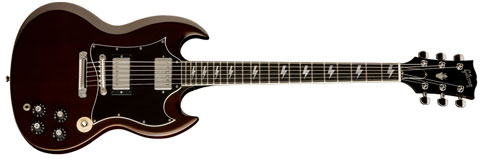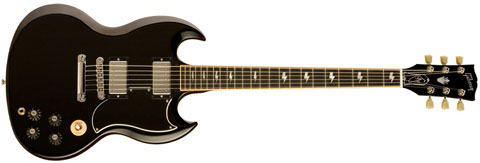What To Learn from the New Angus SG
New ‘Signature’ Pickup…
You may be aware that Gibson recently announced two new signature Angus Young Gibson SGs. One is a custom shop model – the Angus Young SG Standard – and the other is a Gibson production model that has the same name minus the Standard. We can learn about what kind of tone Angus is looking for by dissecting the custom shop model because that’s the one Angus spec’d out. So here we go.
Woods: Maple Neck
Naturally the body is mahogany – I’m assuming better-quality mahogany than used in regular Gibson guitars.
Gibson had this to say about the body wood: “Mahogany is a medium-dense wood with excellent resonance and superior sustain, and it offers a rich, round, warm tone, but with plenty of high-end sheen and good midrange presence. The mahogany of the Angus Young SG also lends a percussive snap and some added clarity to the tone of the guitar.”
Not sure about that last part, but real mahogany will have warm tone and good lower-mids. Re: “real mahogany,” manufacturers apply the terms mahogany, ash and others to woods that are not really those woods – a rant for another time, and one that probably doesn’t apply to this high-end guitar.
The SG Standard has an ebony fretboard (standard Gibson 12-inch radius). Ebony is harder than rosewood but not as hard as maple, meaning tonally it’s brighter and more articulate than rosewood but not as bright nor articulate as maple. In my experience it’s also faster (meaning your fingers move faster on it) than both rosewood and maple. It’s my favorite fingerboard wood.
Ebony is expensive now and not on as many guitars as it used to be. I should also mention that ebony is the fingerboard wood on the Les Paul Custom.
Worth noting is that this SG has a maple neck (quarter-sawn), not mahogany. Maple means a brighter sound – Gibson says, “outstanding string clarity and definition from the maple” – and a more solid structure. Maple also means less neck movement in climate changes, something Angus (or his tech) no doubt appreciates.
Gibson adds that maple “has the strength required for a thin carve as applied to this model.” Re: the neck profile: “The neck on the Angus Young SG is carved to Angus’ own requirements and models the super-slim yet extremely comfortable profile of his own original ’68 SG Standard” upon which this guitar was based – and which had to have a mahogany neck.
So Gibson implies that the maple is needed for such a thin neck. But the other signature Angus SG has the same neck profile and is mahogany. Go figure.
This all appears to mean that for whatever reason(s), Angus wanted a maple neck.
New ‘Signature’ Pickup
Last month I posted about how Seymour Duncan himself was helping Angus and his tech with a new pickup based on the Billy Gibbons-inspired Pearly Gates pickup. Looks like that’s exactly what happened since the new signature SG Standard has exactly those pickups, one of which has been customized. Here’s what Gibson says about them:
“The Angus Young SG is equipped with a pair of Seymour Duncan Pearly Gates pickups, which include a standard [Pearly Gates] in the neck position and a bridge-position [pickup] that has been modified for higher output.” The pickups “provide an authentic vintage-humbucker tone that Angus Young seeks in his guitars.”
Notably, the magnets in Pearly Gates pickups are Alnico 2s (aka, Alnico IIs). The Gibson Angus Young Signature pickup, which is in the bridge position of the other new Angus Young SG, uses an Alnico 5 (or V) magnet.
Alnico 5 magnets typically allow more highs and lows (tighter lows) through and to my ears have a fast attack. Alnico 2 mags will emphasize the midrange, and will have a softer attack.
The new Angus signature pickup is wax-potted to reduce feedback. Wax-potting supposedly reduces some of the perceived “air” around notes, but I’ll take no feedback over that anytime.
Seymour Duncan has said previously that it would not be selling the overwound Pearly Gates as a signature pickup (Seymour Duncan says the Pearly Gates is already “slightly-hotter-than-vintage”). Maybe Gibson will. Either way, I’m sure you can order one from the Seymour Duncan custom shop.
Other Items of Interest
Those are the most notable takeaways from Angus’ new axe: maple neck/ebony fingerboard, and new signature pickups. But here are a few more items of interest:
> Bone nut, 1.555″ wide (super-slim!).
> Chrome 12:1 Schaller tuners.
> Nickel-plated zinc ABR-1 Tune-O-Matic bridge.
> Tailpiece is chrome-plated Zamak, or Zamac. Wikipedia says Zamac is “a family of alloys with a base metal of zinc and alloying elements of aluminum, magnesium and copper.”
> Average weight of the guitar is 5.65 pounds – light!
> Color = custom-designed “Angus Cherry.” Finish is a “pre-worn” nitro.
> Volume controls use CTS pots (no value given), tone controls are bypassed “as is the case with Angus’ original.”
> Gibson lists nothing about fret size or fret material – odd for such an expensive guitar.
> And of course the pearl Ace Frehley Les Paul-like lightning-bolt fret inlays (apparently Angus had them first).
The MSRP is $9,409!
The Other New Angus SG
Listed at almost $6,000 less, the other new Angus SG also is mahogany-bodied, but has a mahogany neck with the same super-slim profile. It also has an ebony fingerboard.
Other differences from the custom shop model:
> Corian nut, and plastic fingerboard inlays.
> Gibson Angus Young humbucker (see below) in the bridge, Gibson 57 Classic pickup in the neck.
> Tone controls are hooked up – 500K non-linear tone pots with a .0223mf capacitor “for a smooth and gradual roll-off of the pickup’s treble content.”
> Tune-o-matic bridge is chrome over zinc.
> Kluson tuners.
> Color = gloss black (aka ebony).
Things that may or may not be different (not mentioned in custom shop model specs):
> Jumbo frets.
> Linear 300K volume pots.
Notable: Angus’ ‘Old’ Signature Pickup
Info from the Gibson website:
> Enamel-coated wire (43-gauge), Alnico V magnet, matched coils, nickel cover, wax-potted twice.
> “Somewhat akin to the [Gibson] 498T ‘Hot Alnico'” with “slightly overwound coils.”
Notable: Angus’ Other Gear
By now it’s a well-known fact that Angus uses old Marshalls and, occasionally, Wizard amps which are Marshall-like boutique amps. Here’s a brief overview from a Gibson.com article:
Angus “has run the gamut of [Marshall] models through the course of his career, from the JTM45 with which a lot of his recorded work is associated, to JTM50s and JMP50s, to the multiple-stacks of big custom JMP100s that are often used live. And…he always sounds like Angus Young.
“Angus has gigged and recorded mostly through Celestion speakers over the years, preferring G12H-30s for a time, and using Vintage 30s in more recent years, with a cab of G12M greenbacks thrown in now and then for good measure. Lately, however, in the live arena he often runs through an isolation cab under the stage, which is miked and fed into the massive house PA and monitor systems.
“Angus attacks his .010-.048 gauge strings with an extra heavy pick, and augments his technique with a lot of hammer-ons and -offs from a strong left hand.”
I thought he used heavier strings, as I believe Malcolm does.
Notable
> Angus’ number-one SG is an original 1968 Standard model that originally had a Lyre vibrato tailpiece that was removed by Angus and replaced with a fixed tailpiece.
> Re: AC/DC, don’t forget you are also hearing a lot of Malcolm, whose tone is huge, great and hugely underrepresented in discussions about AC/DC tone.
Category: AC/DC, Celestion speakers, Marshall, Seymour Duncan, SG
















The $9,409 MSRP is for the hand-aged/signed version. With only 50 made world wide.
The MSRP for the non hand-aged/signed version is $6,115. With 200 made world wide, and the actual in store/ online price is about $4,299.
Angus had the lightning bolt fret markers long before Ace Frehley. Angus had a custom made Jaydee SG in 1981 by John Diggins (who also made the Tony Iommi Old Boy) was the first lightning bolt SG. His original 71 SG debuted with the lightning bolts around 86 i think this repair was also done by Diggins. Ace Frehley didn’t get his until his 1997 custom shop les paul. It always gets on my nerves when people say it was first done by Ace when in actual fact Angus had them good decade before Ace nicked them.